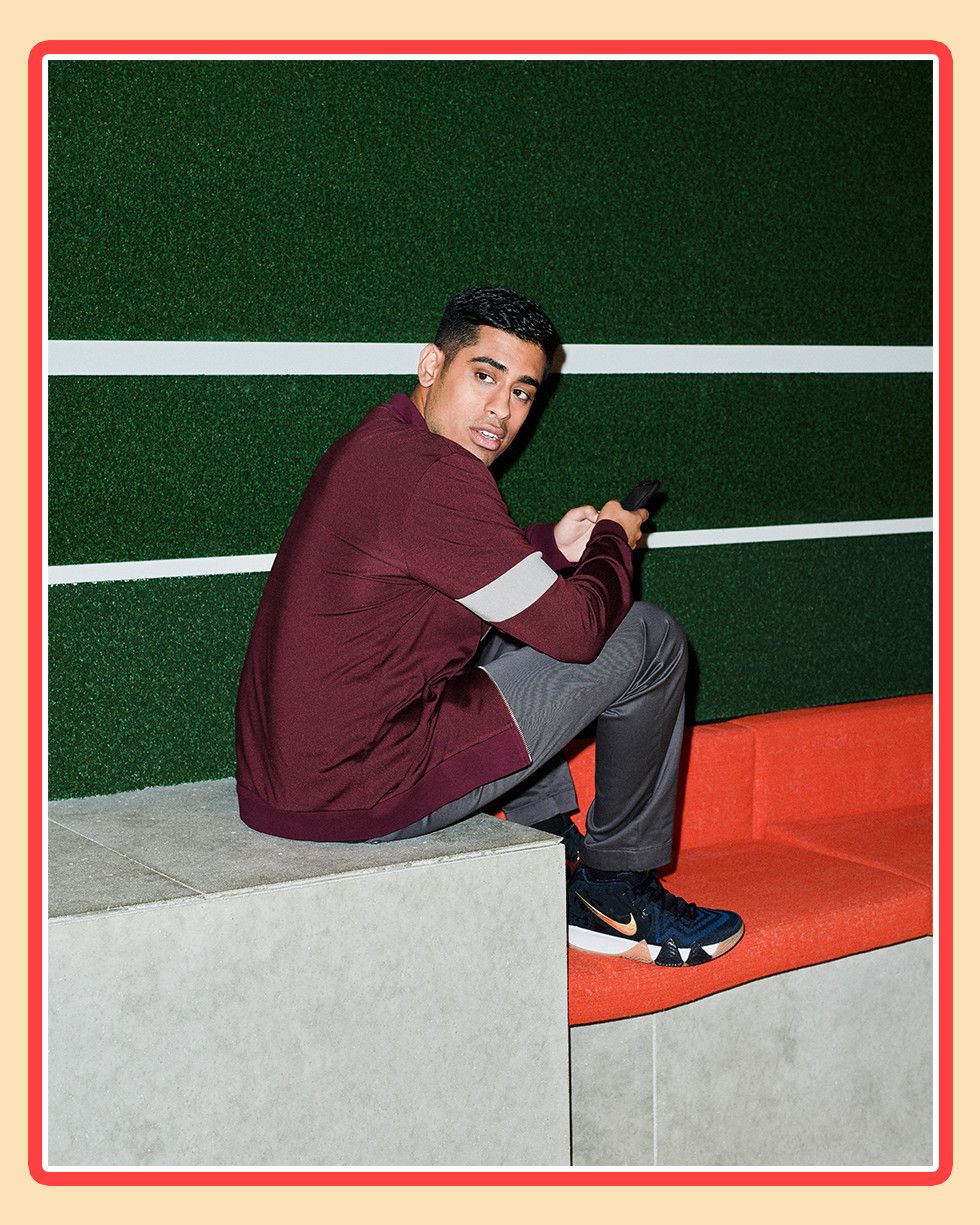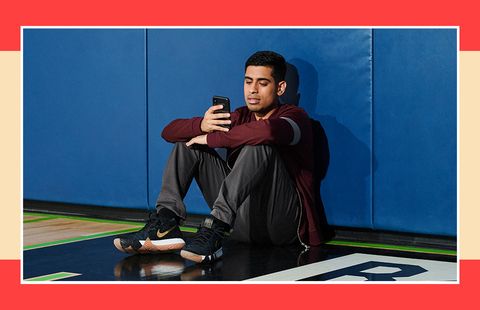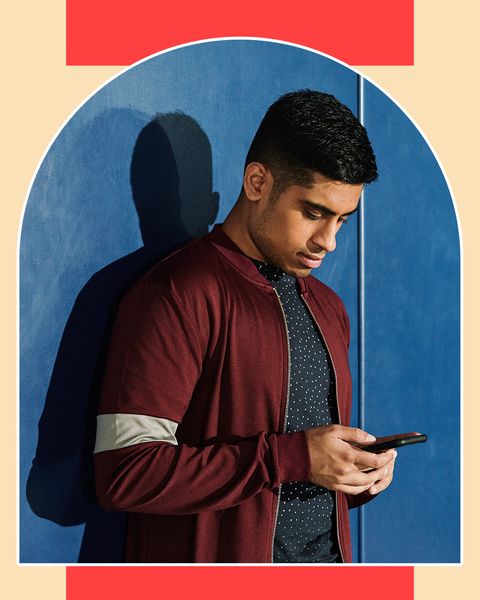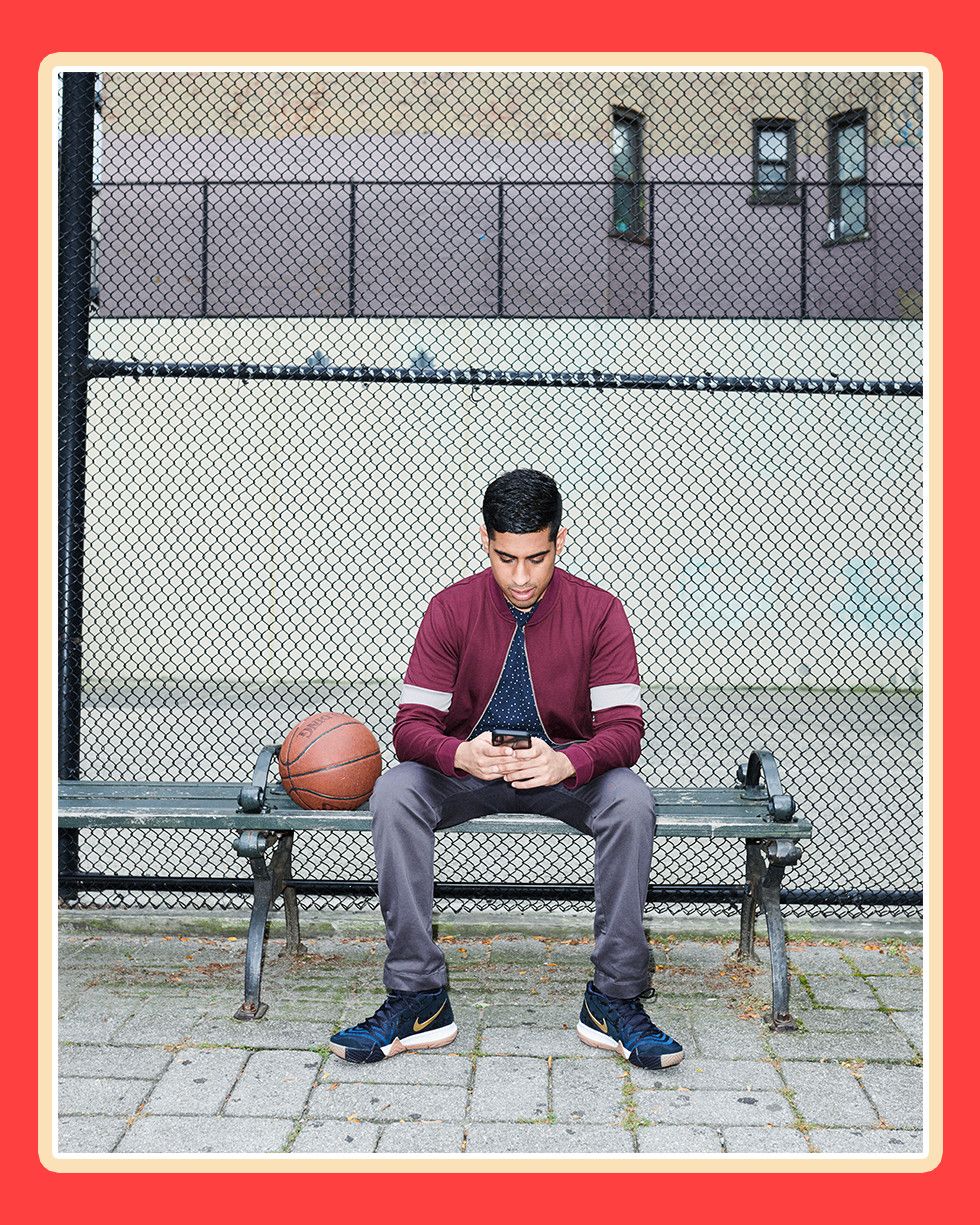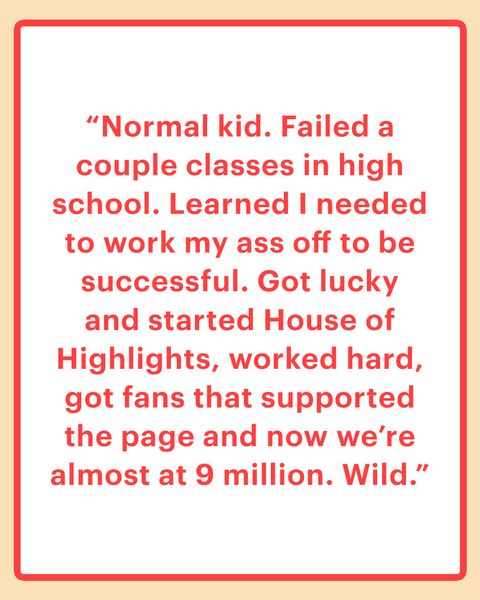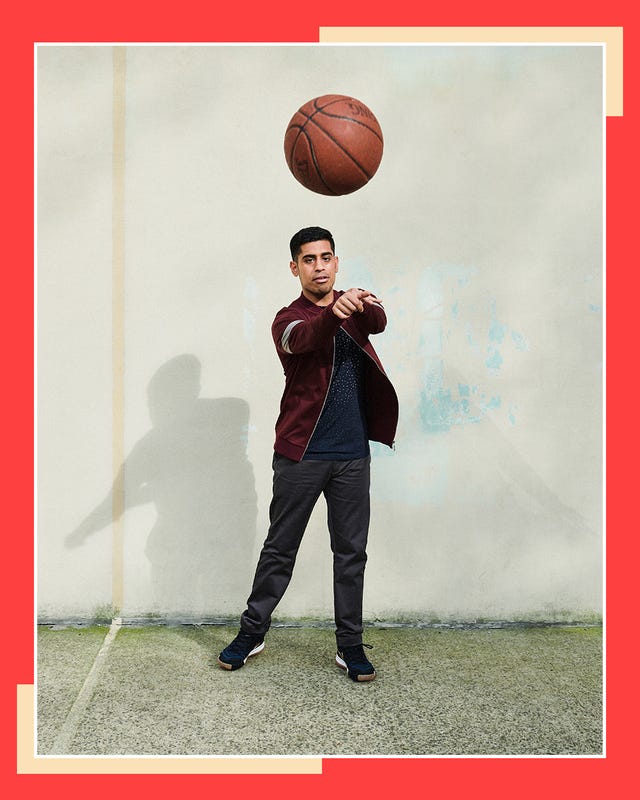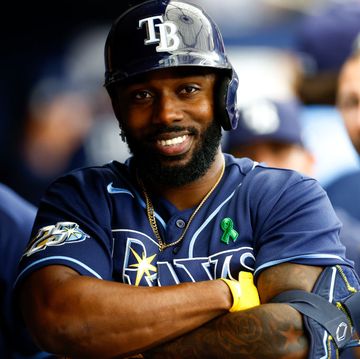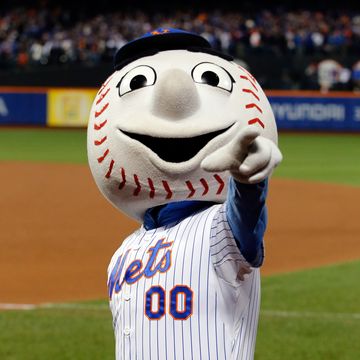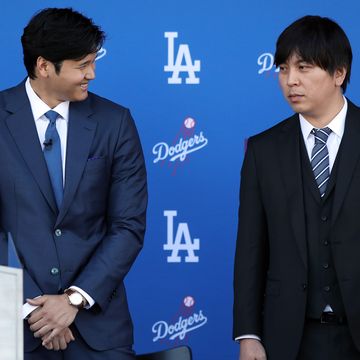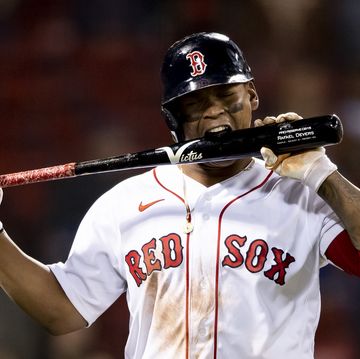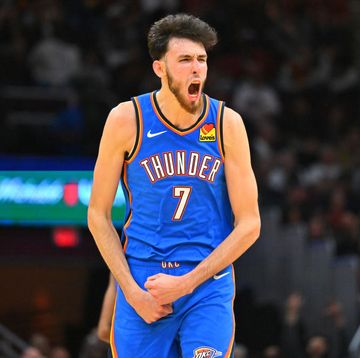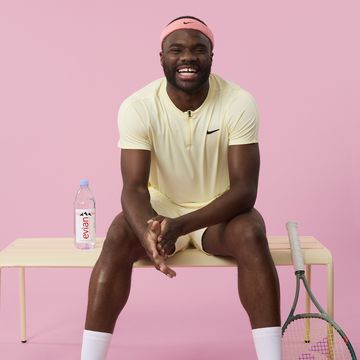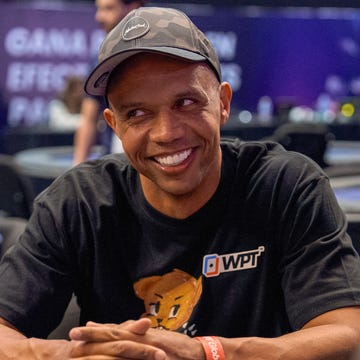When Omar Raja watches sports, he sees moments you and I cannot. It’s an impressive and hard-earned talent, but occasionally a fickle one, too. So just to be safe, the 24-year-old positions himself in front of two separate flatscreens in his tidy Hell’s Kitchen apartment and cranks the volume of NBA games to a near-abusive roar. His 65-inch television’s display is arranged in a grid, so that four contests can play simultaneously. A smaller screen, mounted on a nearby wall above a rack of scuffless Lebron 15s, is tuned to yet another broadcast. His laptop is reserved for Miami Heat games, which he is loath to miss; and his iPhone, retrofitted with a battery add-on that doubles its lifespan, rarely leaves his hands.
As the founder and primary custodian of House of Highlights—an immensely popular Instagram account featuring viral moments from both professional and everyday athletes—Omar is responsible for identifying the day’s most important dunks, threes, picks, jukes, blocks, snubs, sneers, cheers, fights, slights, and other miscellaneous oddities. Like sports itself, it is a blink-and-you-miss-it business. At the height of the NBA season, he works late into the night, identifying moments that strike him as impressive or charming or peculiar, then cutting them into clips and broadcasting them to the more than 10.8 million people who follow his page. Speed matters. If something noteworthy occurs right before a commercial break, he challenges himself to get it out before gameplay resumes two minutes later. The days are spent assessing the efficacy of the previous night’s work and combing through hundreds of videos submitted by fans—many of whom are professional athletes themselves.
He posts about 12 clips per day, tends to stay up until about 3 a.m., and has not taken a vacation in four-and-a-half years.
You could say Omar’s main competitor on Instagram is ESPN, even though its budget, staff, and overall infrastructure are light years ahead of House of Highlights’. The number that really matters is followers, and the Worldwide Leader in Sports has 316,000 more than Omar—a fact that it’s fair to assume is lost on exactly zero of the parties involved.
The Most Viewed Post in HoH History at 5.6m views.
Indeed, as House of Highlights ballooned from a dorm-room pipe dream to a sports entertainment party-crasher, the industry’s old guard has undergone a sort of augmented grieving process: denial, bewilderment, frustration, and, finally, brazen copycatting. Bleacher Report, a member of what might be considered its newish guard, came calling about an acquisition in 2015; it was finalized the following year for an undisclosed price.
Through his account, Omar has achieved the sort of translucent pseudo-fame only today’s social media environment is capable of bestowing. He has spent years behind the curtain, speaking to his fans through wry captions and friendly commentary. It has been a comfortable, lukewarm notoriety—perfect for a quiet son of Pakistani immigrants who still has yet to grasp how much he’s bent the sports media industry.
But the world has grown impatient with the mystery. Fans of the page flag him down at Knicks games and on the streets of New York. Professional athletes invite him to parties and give him pep talks about work and success. This fall, he’ll step in front of the camera to host a House of Highlights talk show, slated to be broadcast on Twitter.
It all points to a question that many of the account’s diehard followers have pondered for years, ever since a friend name checked Omar deep in the comments of one video. The inquiry has rippled outward, towards everyone concerned with sports, and how we consume them, and how quickly the relationship between those two things can shift, and what the sports entertainment industry will look like when they do.
Who is Omar?
Hayder and Ismat Raja, Omar’s parents, moved to Pembroke Pines, a suburb of Fort Lauderdale, in the late 1990s after emigrating to the United States from Pakistan. Omar’s fondest memories are of Sundays as a young boy: his mother working on dinner in the kitchen; his younger sister ricocheting through the living room, shrieking about god-knows-what; his father hurrying back from work to catch the Miami Dolphins game. Under his tutelage, Omar learned to obsess over sports—if not exactly play them.
“I just was never that good, never good enough,” he says. “If I wanted to get a consistent jumper, I would have to go in the lab and just practice by myself. I don’t like doing things by myself.” Over years playing pickup basketball, his greatest gift has always been vision—an ability to see openings a split second before anyone else, then sprint toward them for an easy opportunity.
In middle school, Omar and several of his friends were targets of racist bullying. “We all kind of got it, me and almost all of the brown kids I knew,” he says. “You didn’t even have to be Muslim. If you were Indian it happened.” Amid the abuse—being called a terrorist, being told to go back to Pakistan—his sense of humor sharpened. It became a tool for redirection, a sort of social eject button. "You want to be the guy that makes everyone laugh, so that people can overlook whatever joke they were going to say," he says.
These years also helped birth a competitive streak—an instinct friends sometimes stumbled across by accident. Waaris Zaheer, a classmate at the University of Central Florida, where Omar majored in business, remembers a flag football game the two were part of one winter afternoon. Omar was usually a competent receiver, but on this day, he couldn’t buy a catch.
“He was just coughing up every ball,” Zaheer recalls. “We ragged on him a lot about it, and he would get so mad.” Omar made excuses; he blamed the cold air, even though the South Florida weather had been balmy. From that point on, Zaheer says, “he would always try to set up football games, like, ‘I’m gonna prove you guys wrong the next time we play!’”
Throughout college, Sundays remained hallowed days of sports hyperconsumption. Omar, Zaheer, and a group of their friends often spent the better part of the day at Miller’s Ale House, a sports bar in Orlando, watching several games at a time. It was, in some ways, a precursor to the viewing experience House of Highlights cultivates today: A giant party of friends, swooping from screen to screen, peering at different games and reporting back to each other about big plays and outcomes.
“You just get used to looking at five different screens at once,” Omar says. “When it would reach like 3:50, and that first wave of games was coming to a close, there was so much going on. There were just so many people yelling about different things. That was the moment where you’re just trying to keep track of every single thing that was happening.”
Omar, a Muslim, never drank during these outings. He still has never tasted alcohol or smoked. Instead, he brought a laptop to do schoolwork.
In July 2014, the summer after Omar’s sophomore year, NBA superstar LeBron James surprised the sports world by announcing that he was headed back to the Cleveland Cavaliers, the team that had initially drafted him in 2003. For Miami Heat fans, the departure was the basketball equivalent of snapping the engine off a luxury jet at cruising altitude. It gutted Omar.
To cope, he created an Instagram account dedicated to Miami’s short-lived dynasty and installed a photo of Heat star Dwyane Wade as its avatar. Omar combed through years of footage, posting alley-oops and game winners. But he also began to obsess over the small moments—the stuff that all the major television networks seemed to miss: The spats and videobombs and pre-game handshakes. Gradually, the page broadened into highlights from other teams.
The audience came quickly, “like a snowball effect,” Omar says. “People were tagging their friends, who would tag other friends, who would tag other friends.” Remarkably, he was never asked to remove a video for copyright reasons.
One early success was a six-second clip of former Cleveland Cavaliers point guard Kyrie Irving dunking on a wall-mounted Nerf hoop as two shirtless friends looked on. Years later, it reads like a blueprint for the account’s future: impressive yet goofy, polished yet relatable. The video made the rounds through sports blogs, with many linking back to House of Highlights. Before long, the page had reached half a million followers.
This all caught the attention of Doug Bernstein, then the vice president of social media at Bleacher Report. On July 1, 2015, he emailed Omar, asking if he’d like to chat in the near future.
“I'll keep it pretty simple,” Bernstein wrote. “We are looking to see if there are opportunities to work together.”
Omar wrote back two minutes later: “You available to talk now?”
Doug: “would you be free in 30 minutes?”
Omar: “Should be unless some crazy Free Agency news drops.”
When they got on the phone, such news did drop: The all-star power forward Kevin Love announced he would be joining LeBron James and Kyrie Irving in Cleveland; a new superteam was born. Omar excused himself to tend to his account.
Bernstein was caught off guard. “I remember thinking: Here is this kid that is being presented with this opportunity. Anybody else in his shoes would be like, ‘Oh I’m so excited to talk to you! I’ll put everything else on hold to have this conversation!’
Then another thought hit him. “I don’t really want that kid. I want the kid who’s going to hang up the phone.”
The negotiations lasted for several months. All the while, Omar continued with school. During his senior year, after Bleacher Report acquired the account in January 2016 and offered him a job, he pitched House of Highlights as a capstone project in “New Venture Design,” a business course. The syllabus promised that students would learn “how to evaluate entrepreneurial opportunities” and the art of “creating and adapting initial ideas based on customer feedback and research.”
Omar prepared to coast. “In my head, I was like, ‘This is going to be a joke, because I have the whole thing outlined already and no one really knows.’”
He got a B. The idea, his professor told him, was “just not realistic enough.”
One morning in late May, the House of Highlights team was huddled around a desk in Bleacher Report’s capacious Manhattan office. Omar was wearing a pink button-up, slim-cut jeans, and a pair of gray Kobe A.D.s. He is thin and considerably shorter than the athletes over which he obsesses, with dense black hair and a wide, toothy smile. It was the Friday before Memorial Day, and much of the company’s staff was on vacation. Others had been given the day off when a Bleacher Report executive lost a ping-pong match—and an accompanying bet—to an underling the day before. The result was an eerie silence, broken only by the team’s debate over whether the Houston Rockets could possibly upset the Golden State Warriors in the Western Conference Finals.
In conversation, Omar has a tendency to pump intrigue into otherwise simple declarative statements. He often tacks on a “this was interesting–” or a “what’s interesting about that is– ”, as though to prime you for inevitable fascination. It’s unclear if this tic is a function of awed surprise at his own good fortune, or a sort of semiconscious sales pitch, or both.
Around the office, he is referred to as “The Mayor of Bleacher Report” (or simply “The Mayor”) because he loves to wander—past the TV studio, Rihanna mural, and ping-pong tables—asking colleagues about their interests. More specifically, he likes to know how people found something they love: a song, a television show, a sneaker. How did it cut through everything else and demand their attention? He wants to see what they see.
Most Liked Post in HoH History
This trait is useful. House of Highlights’ audience is predominantly people under 24, a demographic that’s notoriously difficult for conventional media to reach. When Bleacher Report bought out Omar, it wasn’t just paying for his sensibilities; it was inviting itself, like a keg-toting 29-year-old, into a party of Gen-Z sports fanatics. Today, the behaviors of these viewers–how many are watching and reacting, how many are still out there–is a point of obsessive scrutiny and dissection. During the NBA season, the page averages about 700,000,000 video views per month and a has a daily pickup of 10,000 new followers.
While House of Highlights has grown sharply, the old-guard in sports media has seen its fortunes fade in recent years. The behemoth, ESPN, has shed more than 10 million subscribers in the last seven years, conducted rounds of painful layoffs, and spooked investors. Fox Sports 1, which was introduced with great promise in 2013 as a challenger to ESPN, has struggled to gain traction.
ESPN still hauls in billions in revenue each year (thanks to cable TV subscriptions and the eye-popping rates it charges advertisers for live-sporting events) and employs thousands of people. Its streaming service, ESPN Plus, crested 1 million paying subscribers after just five months. In the other words, the network is catching up to digital realities. But it was slow to see what Omar did—that viewer's habits are changing, that young people have ditched cable and seek out sports highlights on social media and other platforms.
The result is nothing short of a sports broadcasting identity crisis.
“I have a 15-year-old son,” says Gus Ramsey, a former ESPN producer who’s now a program director at Full Sail University’s Dan Patrick School of Broadcasting. “There’s never a time when I say to him, ‘Hey, did you see – ?’, and his answer is ‘no.’ He’s seen everything.” For many young viewers, the surprise factor that shows like SportsCenter once used to keep audiences captive is gone. And the reason, Ramsey says, is simple: “Why am I going to sit around and wait to see this on TV when I can watch it on my phone right now?”
Because it’s owned by Turner Entertainment Company, Inc., Bleacher Report can grant House of Highlights nearly unbridled access to NBA games and all of their requisite moments. Even before it was acquired, the page benefited from league Commissioner Adam Silver’s laissez-faire attitude toward social media sharing, which he likens to “snack[ing]” on full games. Soon, House of Highlights will begin posting clips from Champions League Soccer, a sport whose biggest stars dwarf the NBA’s in both their international renown and their Instagram fanbases.
All that’s only half of the equation, though. The other half, the thing that Omar and his team do so well, is recognition—of trends, moments, opportunities. Consider the #DriveByDunkChallenge, a viral phenomenon that originated from one fan’s video. It worked like this: You cruise slowly through a neighborhood, looking for unattended basketball hoops. Once you’ve found one that is either regulation height or lower, you exit the car with your ball, dunk it, then escape with a bank robber’s urgency.
At first, fans started submitting videos of themselves pulling this off. Then the pros started to participate: New Orleans Pelicans all-star Anthony Davis, Boston Celtics small forward Jaylen Brown. Eventually, James Harden, 2018’s MVP, upped the ante: In his video, he parks a speedboat at a dock in Miami, barrels into a stranger’s pickup game for a decadent flush, then jogs away giggling. (Equally engrossing are the myriad fails: Would-be dunkers accidentally snapping decrepit hoops, slipping on puddles and being chased by pissed-off dogs.)
Then there was “Hoodie Melo,” a viral movement built around the 10-time all-star Carmelo Anthony. In May 2017, Omar spotted a video that Anthony’s trainer, Chris Brickley, had posted on his own Instagram account. In it, Anthony is working out indoors, looking particularly fit and determined, his hooded sweatshirt drenched in sweat. Omar re-posted the video, then several others, all of them featuring Anthony in the new costume. A mystique grew around the sweatshirt, which begat a nickname and alter ego: “Hoodie Melo.” Perhaps aware of the meme’s power, Anthony continued to overdress during workouts and high-profile pickup games. More buzz grew. Finally, as the Thunder tipped off their first game of the season, Nike’s Jordan brand debuted a “Hoodie Melo” sweatshirt. The entire inventory sold out in seven minutes.
Searching for the next meme-able moment, and sniffing out the potential to monetize it, consumes a significant portion of the House of Highlights team’s time. The day I visit in May, it spills over into lunch at Carmine’s, an Italian restaurant near the heart of Times Square.
As they wolf down chicken wings, the team, at the time composed of Omar and Doug Bernstein, as well as colleagues Drew Corrigan and Sam Gilbert, tosses around ideas about their forthcoming Twitter show, which seems very much in a “concept” phase. They consider asking NBA players to confront their biggest fears—spiders, say, or waterslides—on camera. Bernstein asks if anyone liked a recent idea he had about something called “phone call roulette.” They praise James Corden’s Carpool Karaoke for its simple production and Breaking Bad for its pacing.
“It’s all about the execution,” Omar says as a mountain of chicken parm arrives, “because none of it sounds good on paper.” His eyes flit from his food to his colleagues to his phone. The pile of direct messages is growing, which makes him visibly uneasy. Hundreds of teenagers are urgently trying to notify him they’ve dunked on a friend, or sunk a hole in one, or punctured the spleen of an opposing QB.
Bernstein suggests adding musical guests to the end of each show. Omar smiles, his eyes now glued to his phone.
“You must have one hell of a budget, dude,” he says.
How much of Omar’s success is due to some unique entrepreneurial skill, and how much is the result of perfect timing, a slightly above-average understanding of social media, and a dash of good luck?
To answer that question, it’s helpful to contrast House of Highlights with one of its most aggressive competitors on Instagram, Barstool Sports. Although Barstool’s account has roughly half as many followers as House of Highlights, its fanbase is rabidly loyal and its posts are often viewed by twice as many people. On Instagram, Barstool’s aesthetic is lewd and often cruel; it is concerned less with sports themselves than with drunk women and dick jokes and user-generated videos of people seriously injuring themselves.
To follow both accounts is to impose a sort of digital referendum on your own morality. On June 11, Omar and his team posted a video of a teenage pitcher striking out a batter to win a high school state championship. As the pitcher’s teammates run to the mound in celebration, he pushes past them to comfort the batter, who we’re told in the caption is a childhood friend. They embrace for several seconds before rejoining their respective squads. That same day, Barstool posted a video of another youth baseball game, shot from a nearly identical angle. In it, a young boy winds up for a swing and is beaned in the neck by an errant pitch. He collapses to the ground as the umpire, manic, waves his hands to stop play. Barstool’s caption: “Right in the larynx.”
Omar and his team look for videos that align with three ideological pillars: inclusivity, celebratory, relatability. They often post videos of athletes with disabilities and include affirmative captions–sometimes just “This is awesome”–next to them. On the rare occasion when their comments ecosystem turns toxic, they pull posts down.
“People go to Instagram as a way to talk to their friends,” Omar says. “So the way I view it is like, I’m just talking to my friends.”
To follow Barstool, on the other hand, is to rubberneck shamelessly. Over the summer, the account’s team posted a video of an overweight woman in a wheelchair being dragged by a motor scooter and thrown to the ground. It was quite popular. One commenter wrote, “That’s a lot of surface area to be road rashed.” Another wrote, “what's the matter thunder thighs, I thought you chubsters were a happy lot.”
Given the Internet’s natural inclination toward viciousness, it’s difficult to predict whose approach will ultimately yield better returns. But House of Highlights’ positivity has continued to attract followers at a rapid clip, including celebrities like Dwayne “The Rock” Johnson and Justin Timberlake–as well as many of the same athletes that are featured on the account. When Kyrie Irving followed the page, Omar reached out in a direct message to thank him for doing so. Irving wrote right back:
“Appreciate you brother and your true eye for art through sports. You show respect and love and…thats all us athletes and fans want. Keep being you always. You always have my support.”
Although Omar is by all accounts low-key and low maintenance, he is stubborn about what should and should not appear on House of Highlights. And, on any given day, he is obsessive about responding to inquiries from his followers, famous and non. Deep in the comments of a post earlier this year, a user named dominicgeiss7 asked, “Omar, what’s your life story.”
He banged out a response—typo and all—within the hour. “Normal kid. Failed a couple classes in high school. Learned I needed to work my ass off to be successful. Gott lucky and started House of Highlights, worked hard, got fans that supported the page and now we’re almost at 9 million. Wild.”
One evening in late May, Omar saw into the future.
It was Game 5 of the Western Conference Finals–effectively this year’s ultimate NBA contest, given that LeBron James somehow managed to drag a handful of scarecrows through the Eastern division’s playoffs and past an injury-addled Celtics team. The Cavaliers were sure to get pummeled by either the Houston Rockets or the Golden State Warriors, who were unequivocally the NBA’s top two teams.
And here those teams were, neck and neck in Houston as the fourth quarter clock wound down. If the Rockets won, it would mean a 3-2 lead in the best of seven series. Unseating the Warriors, this decade’s (and perhaps this generation’s) most dominant team looked possible. The crown was in reach.
Omar was watching in his apartment. Suddenly, something felt different. “The fan in me came out,” he says. “I felt like I could’ve been witnessing history.” He thought ahead 10 years, to a time when he would tell the story of this game to his own children and their friends. He would need to get the details right. These were, after all, the sort of stories his father told him about Miami Dolphins quarterback Dan Marino–moments to be passed down, moments from a time before everything was instantly clipped, catalogued, and commented upon.
Omar put down his phone and did something he rarely gets to do. He watched, free of obligation or distraction. He allowed himself two minutes of gameplay–enough time to enjoy Chris Paul’s cocky dissections of opposing big men; Stephen Curry’s mid-air acrobatics. It was Omar’s first such indulgence of the entire 2017-2018 NBA season. Enough time to see the Rockets eke out a close win before ultimately losing to the Warriors in seven games.
It didn’t last long. After the game ended, he backed up his recording, squinted his eyes, and started looking for moments to share.
